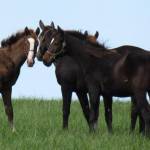Providing Dietary Calcium and Phosphorus to Horses

Calcium and phosphorus comprise most of the mineral matter in the horse’s body. Approximately 80% of the phosphorus and 99% of the calcium are located in the bones and teeth, so they are vital in the formulation of the diet. The horse must receive adequate quantities of calcium and phosphorus and in the correct ratio. If the amount of phosphorus exceeds that of calcium, the excess phosphorus will interfere with the absorption of the calcium, resulting in serious effects on the skeleton.
In growing horses, the ratio of calcium to phosphorus in the diet must be 1:1. During the development of the skeleton, a cartilage base forms first and is then replaced by bone in a process known as ossification. This process requires:
- sufficient amounts of calcium and phosphorus in a digestible form;
- the correct ratio between the two minerals;
- a small amount of vitamin D.
Milk is the perfect food for building bone, and for the first three months of a horse’s life, little improvement can be made to that source of calcium and phosphorus (assuming the mare is providing normal quantities to her foal).
What happens after the foal is weaned and throughout its adult life? Fortunately, many feeds and forages also contain abundant calcium and phosphorus. Legumes such as alfalfa and clover are rich in calcium, and grass hays, such as timothy and orchard grass, also contain calcium, but at lower levels than in legume hays. The phosphorus in hay is more readily available to the horse than that found in cereal grains.
Problems arise if the horse is fed large volumes (more than 50% of the total ration) of unfortified cereal grains that are high in phosphorus without the addition of a calcium supplement. A calcium-phosphorus imbalance can lead to conditions such as secondary hyperparathyroidism in which bone is replaced by fibrous connective tissue (big-head disease). Deficiency of calcium causes skeletal deformities in young horses. In addition, a deficiency or imbalance of calcium or phosphorus can result in osteomalacia or osteoporosis (thinning of the bone) in older horses.
Strenuous exercise (more than 16 km or 10 miles per day) increases the need for these minerals in the diets of mature horses. The bones of all horses are being constantly remodeled to some extent, so the need for some calcium and phosphorus is lifelong.
Although the effect of excessive calcium intake in the horse has not been well established, it seems that high levels in the diet may interfere with the absorption of trace minerals such as iron, zinc, and copper. Additionally, an extremely high calcium intake has been implicated in developmental orthopaedic disorders (DOD), including osteochondritis dissecans (OCD) and epiphysitis.
Most commercial horse feeds contain the correct amounts of calcium and phosphorus for the type of horse for which the feed is formulated. Farms that mix their own feed should have an analysis performed to see if the amounts and ratios are correct.
If a calcium supplement is needed, finely ground limestone may be given. Dicalcium phosphate is given when both calcium and phosphate supplements are required. Thirty grams (1 ounce) of finely ground limestone (calcium carbonate) provides at least 10 g of calcium; 30 g of dicalcium phosphate provides approximately 7 g of calcium and 6 g of phosphorus. If the total amount of calcium is less than the amount recommended, then add enough finely ground limestone to make up the calcium to the amount required. If the total amount of phosphorus is less than the amount required, add enough dicalcium phosphate to bring the phosphorus up to the amount required. Recheck that the ration will meet the recommended requirements for calcium, and if necessary add more finely ground limestone.
As a general rule, if you are feeding mostly grain and oaten chaff, then additional calcium, but not phosphorus, will be required. Approximately 60 g (two ounces) of limestone each day is required. Thoroughbred mares in late pregnancy and lactation should be given 90 g (three ounces) of limestone daily. Horses being fed on dry pasture with hay supplement may require phosphorus to improve the palatability and availability of the calcium in the feed.








